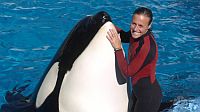 SeaWorld has announced that they are ending their program to breed captive orcas. The 24 orcas, also known as killer whales, currently held at parks in California, Texas and Florida will be the last generation of captive orcas at SeaWorld. In an op-ed in the LA Times, Joel Manby, president and CEO of SeaWorld, wrote:
SeaWorld has announced that they are ending their program to breed captive orcas. The 24 orcas, also known as killer whales, currently held at parks in California, Texas and Florida will be the last generation of captive orcas at SeaWorld. In an op-ed in the LA Times, Joel Manby, president and CEO of SeaWorld, wrote:
Americans’ attitudes about orcas have changed dramatically. When the first SeaWorld Park opened in 1964, orcas, or killer whales, were not universally loved, to put it mildly. Instead, they were feared, hated and even hunted. Half a century later, orcas are among the most popular marine mammals on the planet. One reason: People came to SeaWorld and learned about orcas up close.
For some time, SeaWorld has faced a paradox. Customers visit our marine parks, in part, to watch orcas. But a growing number of people don’t think orcas belong in human care. Lawmakers in Sacramento and even in the U.S. House of Representatives have proposed legislation to phase out orca captivity. Even the California Coastal Commission — a state agency with oversight over land use and public access — moved last year to ban orca breeding at SeaWorld San Diego.
We are proud of contributing to the evolving understanding of one of the world’s largest marine mammals. Now we need to respond to the attitudinal change that we helped to create — which is why SeaWorld is announcing several historic changes. This year we will end all orca breeding programs — and because SeaWorld hasn’t collected an orca from the wild in almost four decades, this will be the last generation of orcas in SeaWorld’s care. We are also phasing out our theatrical orca whale shows.
Some critics want us to go even further; they want us to “set free” the orcas currently in our care. But that’s not a wise option.
Most of our orcas were born at SeaWorld, and those that were born in the wild have been in our parks for the majority of their lives. If we release them into the ocean, they will likely die. In fact, no orca or dolphin born under human care has ever survived release into the wild. Even the attempt to return the whale from “Free Willy,” Keiko, who was born in the wild, was a failure.
For as long as they live, the orcas at SeaWorld will stay in our parks. They’ll continue to receive the highest-quality care, based on the latest advances in marine veterinary medicine, science and zoological best practices.
While opposition to orca whales in captivity had been growing for some time, there was a sea-change in public perception following the death of SeaWorld senior trainer, Dawn Brancheau, in 2010. Brancheau was attacked and drowned by the orca known as Tilikum. The documentary Blackfish, released in 2013, told “the story of Tilikum, a performing killer whale that killed several people while in captivity. Along the way, director-producer Gabriela Cowperthwaite compiles shocking footage and emotional interviews to explore the creature’s extraordinary nature, the species’ cruel treatment in captivity, the lives and losses of the trainers and the pressures brought to bear by the multi-billion dollar sea-park industry.”
Blackfish was a bombshell. CNN broadcast the documentary on October of 2013. It created a strom on social media. In what has become known as the Blackfish effect, SeaWorld’s stock dropped to record lows. Attendence at its parks fell. The president of the firm was forced to resign. After initally attempting to counter Blackfish with their own public relations, an effort which largely failed, SeaWorld is now phasing out using orca whales as entertainment.
